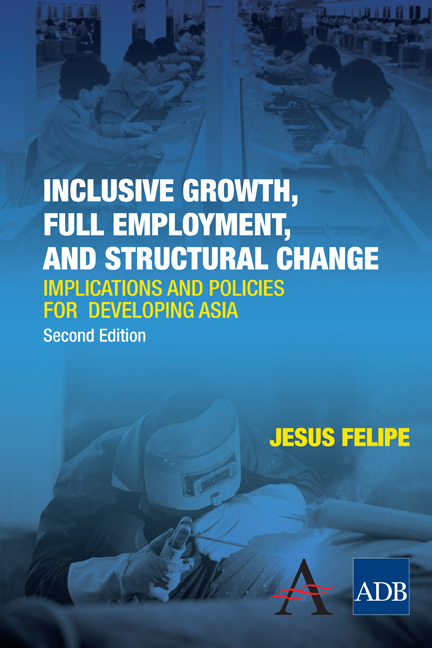 Inclusive Growth, Full Employment, and Structural Change
Inclusive Growth, Full Employment, and Structural Change Book contents
- Frontmatter
- Dedication
- Contents
- Illustrations
- Abbreviations
- Foreword
- Preface and Acknowledgments
- Executive Summary
- Chapter 1 What Is Inclusive Growth?
- Chapter 2 What Is the Main Constraint that Developing Countries Face?
- Chapter 3 Why Full Employment and Who Should Be Responsible for Trying to Achieve It?
- Chapter 4 Why Is Growth Unstable?
- Chapter 5 What Is the Role of Agriculture in the Process of Structural Change and in Delivering Full Employment? Full Employment I
- Chapter 6 What Is the Role of Investment in Delivering Full Employment? Full Employment II
- Chapter 7 Why Is “Planning Development” Necessary?
- Chapter 8 What Is Industrial Policy? Full Employment III
- Chapter 9 Structural Transformation, Industrialization, and Technological Change in Developing Asia: What Does the Empirical Evidence Show?
- Chapter 10 Why Do Export Diversification and Sophistication Matter?
- Chapter 11 Unemployment Versus Inflation: Which One Should Be the Public Enemy Number One?
- Chapter 12 What Should Be the Role of Fiscal and Monetary Policies for Development? Full Employment IV
- Chapter 13 Is It Possible to Achieve Full Employment in the Presence of Structural Transformation?
- Chapter 14 Should the Government (Public Sector) Intervene Directly and Become the Employer of Last Resort? Full Employment V
- Chapter 15 Can Competitiveness and Globalization Deliver Inclusiveness and Full Employment?
- Chapter 16 Export-Led Growth or Domestic Demand–Led Growth?
- Chapter 17 Is Education a Key Ingredient of Inclusive Growth?
- Chapter 18 Conclusions: How Can Developing Countries Implement an Inclusive-Growth and Full-Employment Strategy?
- References
- Author Index
- Subject Index
Chapter 10 - Why Do Export Diversification and Sophistication Matter?
Published online by Cambridge University Press: 10 September 2020
- Frontmatter
- Dedication
- Contents
- Illustrations
- Abbreviations
- Foreword
- Preface and Acknowledgments
- Executive Summary
- Chapter 1 What Is Inclusive Growth?
- Chapter 2 What Is the Main Constraint that Developing Countries Face?
- Chapter 3 Why Full Employment and Who Should Be Responsible for Trying to Achieve It?
- Chapter 4 Why Is Growth Unstable?
- Chapter 5 What Is the Role of Agriculture in the Process of Structural Change and in Delivering Full Employment? Full Employment I
- Chapter 6 What Is the Role of Investment in Delivering Full Employment? Full Employment II
- Chapter 7 Why Is “Planning Development” Necessary?
- Chapter 8 What Is Industrial Policy? Full Employment III
- Chapter 9 Structural Transformation, Industrialization, and Technological Change in Developing Asia: What Does the Empirical Evidence Show?
- Chapter 10 Why Do Export Diversification and Sophistication Matter?
- Chapter 11 Unemployment Versus Inflation: Which One Should Be the Public Enemy Number One?
- Chapter 12 What Should Be the Role of Fiscal and Monetary Policies for Development? Full Employment IV
- Chapter 13 Is It Possible to Achieve Full Employment in the Presence of Structural Transformation?
- Chapter 14 Should the Government (Public Sector) Intervene Directly and Become the Employer of Last Resort? Full Employment V
- Chapter 15 Can Competitiveness and Globalization Deliver Inclusiveness and Full Employment?
- Chapter 16 Export-Led Growth or Domestic Demand–Led Growth?
- Chapter 17 Is Education a Key Ingredient of Inclusive Growth?
- Chapter 18 Conclusions: How Can Developing Countries Implement an Inclusive-Growth and Full-Employment Strategy?
- References
- Author Index
- Subject Index
Summary
The way countries succeed in development is often by finding a big hit in export markets. What will be the big hit is impossible to foresee […] Who would have predicted that cut flowers in Kenya would capture 40 percent of the European market for romantic men bringing flowers home to their wives? You could say the same about women's cotton suits in Fiji (42 percent of the US market), or “floating docks” in Nigeria (84 percent of the Norwegian market), or electronic integrated circuits in the Philippines (71 percent of the world market), or regional jets in Brazil (Embraer now has 22 percent of the world market). Egypt's largest single manufacturing export success, accounting for 30 percent of the total, is bathroom ceramics, of which 93 percent goes to Italy. Can you picture development experts telling Egyptians, “The secret is just export toilets to Italy!?”
—William Easterly (2008, 9)This chapter expands the analysis of structural transformation in developing Asia. I rely on recent work on economic diversification, the importance of export sophistication and the product space. All this body of work has very important policy implications.
Comparative Advantage and Diversification
Recent research by Imbs and Wacziarg (2003) suggests that at low levels of income per capita, economies tend to diversify and subsequently, as their income rises, they then specialize: whatever drives economic development, it is not comparative advantage. Figure 10.1 graphs the degree of specialization in the manufacturing sector in the vertical axis vis-à-vis the logarithm of income per capita in the horizontal axis. As noted above, the new literature emphasizes the importance of diversification as opposed to traditional comparative advantage (i.e., the idea that as countries open up trade, they will specialize in those activities that use intensively those factors that are in abundant supply). Graphically, this corresponds to a U-shape relationship between specialization and income per capita, which Figure 10.1 corroborates. The figure shows increasing diversification as income per capita increases (at low levels) in Bangladesh, India, Indonesia, Pakistan, Sri Lanka, and Thailand. None of these economies become more specialized within comparable low-income ranges. Increasing specialization is only detected at higher income levels in the Republic of Korea, Malaysia, and Singapore. Hong Kong, China seems to be increasing its level of diversification.
- Type
- Chapter
- Information
- Inclusive Growth, Full Employment, and Structural ChangeImplications and Policies for Developing Asia, pp. 157 - 178Publisher: Anthem PressPrint publication year: 2010


